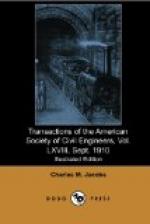During recent years the business population of the lower part of the Borough of Manhattan has become greatly congested. Very high buildings, providing business accommodations for large numbers of people, have been constructed, and these people must move to and from their working places at about the same times, that is, at the “rush hours” in the morning and afternoon, at the beginning and ending of the working day. Every effort has been made to provide for this immense and rapidly increasing local passenger traffic, by the construction of surface, elevated, and subterranean railways; but the demand for transportation has increased much faster than the facilities can be provided, and it is evident that the limit of down-town passenger traffic facilities has been very nearly reached.
Apparently, the only remedy for these conditions is the movement of business and the people transacting it up-town or to the Boroughs of Brooklyn and Queens, which are now readily accessible by tunnels and subways. This movement, of course, is resisted by the great real estate and money interests centered in the lower part of the city, but, notwithstanding this resistance, the improvement has commenced and has rapidly advanced. The great retail houses are being established above 23d Street; the banks and brokers’ offices are rapidly appearing around the new business center of the city. The facilities afforded by the telephone and the subway for communication with the money center have doubtless greatly promoted this up-town movement.
When the Pennsylvania Tunnel Extension is in operation, the easiest and quickest way for the passenger to reach the city from Newark will bring him into the Pennsylvania Station at Seventh Avenue and 33d Street. The schedule fast time from Newark to the New York Cortlandt Street Station is now 25 min. This may be reduced to about 18 min. by the use of the Hudson Company’s tunnels, and while this involves inconvenience in changing transportation at Jersey City, yet it brings the traveler three blocks nearer Broadway. The time from Newark to the Pennsylvania Station will be about 17 min., and the trip will be made without change of transportation, so that, undoubtedly, by far the greater part of the Pennsylvania’s passenger traffic desiring to reach the shopping and hotel center of the city will go to the new up-town station.




